



Featured image: Image from the exhibition: http://gl1tch.us/GlitchArt-wit-jonCates.html
jonCates upcoming keynote, along with the entire Art of the Networked Practice online symposium, March 31 – April 2, 2015, will be free, open and accessible via web-conference from anywhere in the world. Visit the Website to register. The symposium is in collaboration with Furtherfield.
jonCates in Conversation With Randall Packer
we need to humanize ourselves + our systems, to recognize that we are amidst failed futures, broken tools + glitched environments made from media, mediums, mediations + filtered through failures. – jonCates

Describing the world of new media/glitch artist jonCates is a labyrinthine task. You might begin with his spontaneous and inventive word-language actions reminiscent of William Burroughs cut-ups; or the hypnotic .gif animations made from seemingly incongruous, discarded fragments of media; or perhaps his “dirty new media” aesthetic that brings to the surface the aberrations and raw imperfections that are typically verboten in “high-end” digital circles.
jonCates has ironically and quite cleverly co-mingled punk and pirate media with thoughtful theoretical discourses. Based in Chicago, he is Chair of Film, Video, New Media and Animation at the School of the Art Institute of Chicago by day, prowling the sub-culture of the alternative spaces by night. Cates is at the center of a glitch scene in Chicago, now referred to as the “birthplace of dirty new media,” a movement he has in large part catalyzed: spawning the international GLI.TC/H Festivals and other assorted hactivist events and DIY workshops.
In my conversation with jonCates we discuss his unique synthesis of language and media, his critique of technology, and how glitch, in all of its multifarious manifestations, has powered his work, functioning as a force for uniting artists, students, and communities in collective activity.

Randall Packer: I want to start off with the way in which you blend everything – in your life, in your work, your practice, theory, communications, writing, teaching –there is a mélange of language, a spirit and playfulness, that all seems to flow together with glitch. Would you say that glitch is a way of life?
jonCates: yeas, in faxxx, well first off, i would like to say thnxxx for giving the work the level of attn you have. i think that my approach to Digital Arts or New Media Art is 01 that takes a systemsapproach, not in a kind of cold cybernetic way but in a more wholistic sense of systems, those systems might be broken, they might be glitched, + they might be imperfect + noisy, + that might be what attracts us or me to those systems. but still they are functional or rather functioning in one way or another systematically. so they are connected to one another as assemblages.

RP: I would say that glitch is a language, spoken by its practitioners, who have co-mingled code with the spoken word, or maybe I should say specific to your work, mixing machine language with human language: accepting the aberration as perhaps more important than the message. Is the aberration the message?
jC: i would def’ly say that there is a poetic embrace of noise && error. my interests are also, continue to be, motivated by the connections between Noise Musics + experimental New Media Art. for me this approach to noise or noisiness, or dirt, or dirtiness, is a way to foreground as you say, an aberrance or perversion of normative msg or what we might perceive to be logical reasoning. b/c there is a poetics to that obviously. ppl who inspired me most directly in that manner would be Netochka Nezvanova, who did this comingling of functional code w/ highly politicized + poetic language.
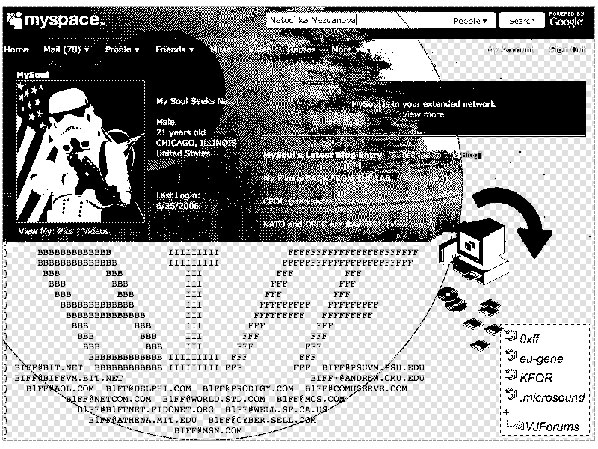
RP: So is glitch an act of undermining the status quo of our relationship to technology?
jC: it certainly can be. i think that there was mayhaps a time recently in witch glitch works were more directly mobilizing that kind of critical stance. but glitch is also folded into aesthetics that are also highly popular so there’s a popularity to the glitch aesthetic which would undermine an argument for saying it is exclusively resistant or exclusively political. it’s just impure.
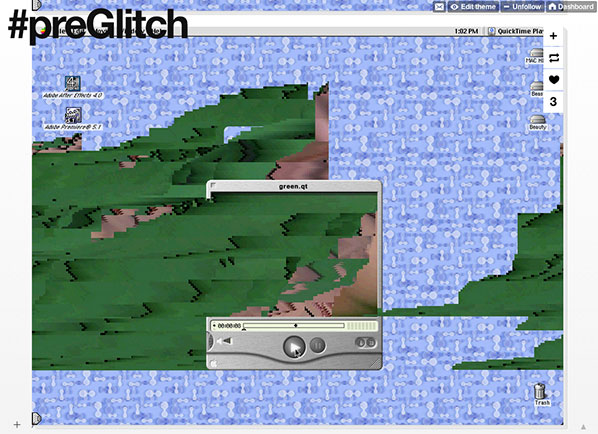
RP: I see many resonances with avant-garde figures both in art and in technology, such as Dick Higgins, for example, in his concept of intermedia. The idea of closing the gap between art and life, media and things, and in your case between language and machine language, art and theory, or as Dick Higgins might have said: art and everything else.
jC: the discourse on art/life, on performance, performance art, those were topics i studied when I was younger: thinking about how technologies that we use are all social. they’re techno-social. we live inna techno-social culture. these technologies are also socially performed, + that means that there are these performative aspects. for instance there is a corporate performance of cleanliness + purity. + then there is the performance of everyday life that we’re all doing all the time w/ all of our technologies. so, we’re making them human, in the sense that we are making them part of our lives.
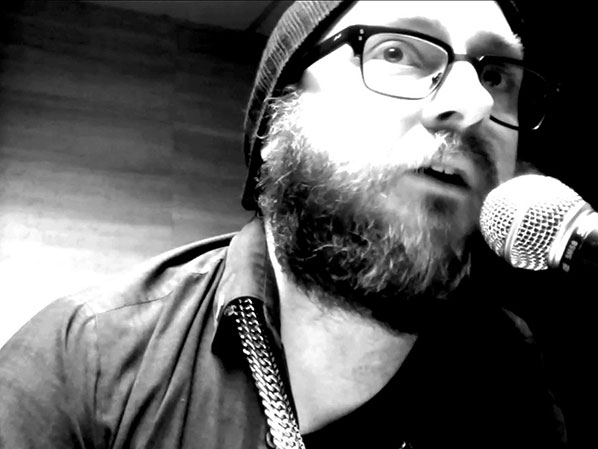
RP: In regards to your idea of “dirty new media,” my response is that the dirtiness implies there is a human quality in new media, that it is not perfect, it’s not sterile, it’s not removed from real life, but it contains its imperfections, it’s impurities, in a way, it’s organic qualities, that get closer to our “wet” lives, rather than our binary ones.
jC: abs’ly! that’s abs’ly a part of the goal in terms of using this term, Dirty New Media OR d1Ɍ+y̶ ̶N̶3WWW_M3DI∆, to foreground all those faxxx. but also that there is a non-neutrality of techno-social artifacts + contexts, that our technologies are not neutral, also that they are embedded, they are part of our lives, + that embeddedness has the word bed in there, we are in bed w/ them also, so they’re embedded in ways that are complex. they are not sterile, they’re imperfect, they are not clean, b/c they exist in the world, which is also imperfect. + so, i do believe that d1Ɍ+y̶ ̶N̶3WWW_M3DI∆ as a way of lyfe + as an approach to artmaking is a way of foregrounding these faxxx, these realities, of our lived exxxperiences, + acknowledging how situated we all are w/ all of these systems, + artifacts that we have made, unmade && remade together.

RP: A lot of people at first glance might look at your work and think that it has been completely usurped by machine language, by a kind of technological sensibility. And so, I am wondering in view of this convergence between human language and machine language the question then might become: where does the machine end and the artist begin.
jC: that’s a gr8 question… well, the machine world is machined by us out of the world + we have literally machined the world. it’s our world, in the sense that we have crafted it. + we’re constantly uncrafting && re-crafting it. it produces errors, mistakes, breakdowns, glitches, noise, + from a Computer Science perspective, what you would want to do would be debugging + refining. but from a d1Ɍ+y̶ ̶N̶3WWW_M3DI∆ perspective, what you might want to be doing is “rebugging,” && pushing different aspects of the machinewwwhirlds to see their thresholds, exxxperiment, + play.
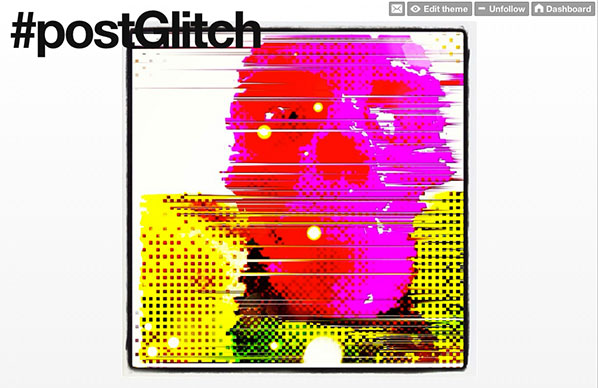
RP: Ultimately there is a playfulness that I think undermines the dystopic view that we sometimes have towards technology. jC: i rly hope that is the case. that’s constantly a goal that i am working on. there are those in my immediate community, + in Glitch Art communities in general, who i am also responding to, who are in fact dystopic, && who are also Discordians, + who are intentionally exploring Chaos Majik or who have aspirations to Kaos Magick, + those kinds of Discordian approaches. && that’s not my intent.
RP: I like the way that you counter the dystopic questions that you get, with an even greater barrage of glitch. For example, there is a comment that Sterling Crispin made when he said: “the glitch/noise fetish is an inversion of humanity & symbolic embrace of death & rampant infectious nihilism.” OK… And your response was:
“thnxxx @sterlingcrispin, my work is an axxxual process of: #glitch #fetish #noise #dirty #newmedia from a #humanist #perspective.”
jC: (laughs) yea, i thought that was funny. i took his comment vry srsly && vry pointedly + it motivated me to write an essay, which is up on the GL1TCH.US Unstable Book for Unstable Media that i am constantly working on. he uses keywords that i am connected to + that have motivated me. he was using fetish, but he was using it in a negatively valenced way + i wanted to reclaim fetish && say, yea, of course fetish is part of what i do b/c fetish is punk + its part of “originary” punk from the SEX shop run by Malcolm McLaren + Vivian Westwood. so, yea, of course, fetish is in my work, but its in this way that’s consistent w/ my art/life inna way that’s dirty, in the sense of being impure, but also (hopefully) sexxxy && exxxciting!
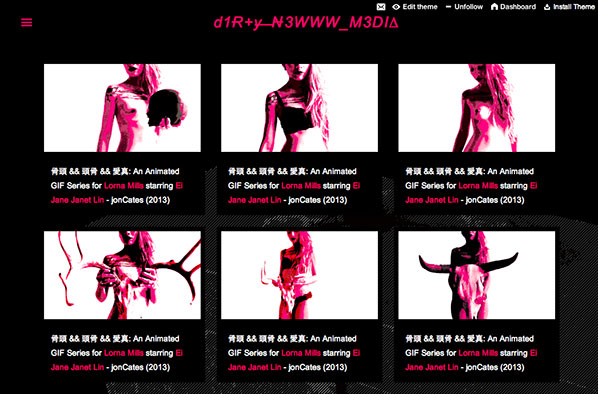
RP: Maybe counter to the world that we live in today with our corporate environment, in which the technology companies encourage a fetish with the slick, clean design of technology. What you have done, is through the construction of a language and a world that you have created, you’ve attempted to break that down and show us what our relationship to technology could be and perhaps should be.
jC: thnxYou! abs’ly! + openUp possibilities, potentialities for ppl, as well as for myself, but also for a community that can mobilize around these approaches, these ideas. it’s counter-intuitive to the rampant, hyper-individualism that lays waste to so much effort that emerges from group practices, communities, to shared or Open Source cultures. this idea of building community, building tools + systems, && sharing those tools + systems w/in the community so that the community can org around all of that + then share work && work goes back out into the communities, to keep it alive. i think i just sketched out a pedagogy! 🙂
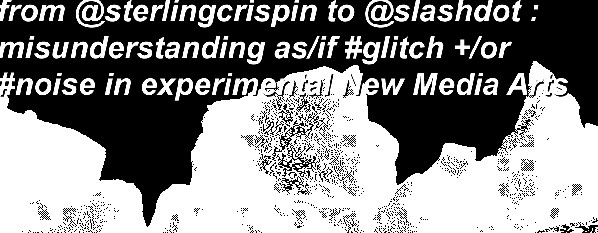
RP: It’s a wonder to me how you balance your personal, artistic and academic life.
jC: it’s a healthy friction for me, it gives me inspiration to work outside of the institution, to work in bars, clubs, DIY/DIT spaces, alternative spaces, it’s a good, healthy dynamic for me. in glitch communities there’s a lot of sharing of technique, + a lot of open sourcing or at least sharing of approaches + practices. so that can have the effect of people learning to reproduce certain styles, or certain aesthetics. but a way to not be stuck on repetition is to focus on glitch as a form of surprise + as a way of glitching ppl’s exxxpectations.

jonCates has several current projects, including the online publication of “Dirty New Media: Hyperthreaded @ GLI.TC/H 2012” by jonCates and Shawne Michaelain Holloway (2014). For more information, visit his Website.
Glitch as an aesthetic signifier of technological presence dates back at least to the 1980s. Look at The Vaught-Kampf machine in Blade Runner (1982) or the titular character in Max Headroom (1985). The use of Glitch as an artistic aesthetic in itself has accelerated with the democratization of newer technologies that make older glitch-prone technology obsolete. When a technology becomes redundant, its previous technical inefficiencies become available for aesthetic recuperation and appreciation.
The hiss and crackle of vinyl records, to be ignored or reduced as far as possible by the mid-20th century audiophile, became signifiers of historical authenticity in 1990s Trip Hop. The lens flare, light seepage and colour shift of cheap mass-produced chemical film-based cameras have been turned from annoyances to fetishes with Lomography (experimental analogue film photography) and Instagram. And the glitches of poor video connections or corrupted floppy disks have followed a similar path in Glitch art.
This is a process of ironisation. Irony changes or inverts content without altering form. Meaning is introduced into systems by ironising non-signifying forms. It is modified and modulated by further ironising those forms. The glitches that once frustrated media professionals and home users of electronic media are ironised into aesthetic form in Glitch Art.
Glitch Art sits in the historical tradition of process art and chance art. Automatism and chance acts in Dada, Surrealism, Situationism and the Oulipo, and Scatter art. Generative and algorithmic art. Action painting provides the useful concept of “all-over composition” as a way of avoiding a requirement of specific, localisable intent in aesthetically, evaluating an image.
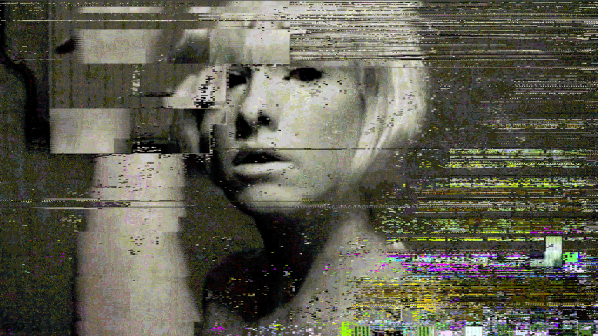
Glitch art also sits in the historical traditions of remix art, detournement and décollage. The knowledge that the image has been altered is key to its aesthetic reception. It’s tempting to talk about the creative destruction of capitalism and to damn Glitch as neoliberal apologia, but that’s too easy and would leave the speaker too comfortable. It is also very tempting to try and place Glitch Art within the traditions of anti-aesthetics or of nominalistic/found art, or to compare the use of image corruption to artistic outsourcing or crowdsourcing in terms of artistic abrogation of authorship. But Glitch is at least curated by the artist, and its generation requires an engagement with the specificities of digital media that they are not supposed to have. The Glitch artist is artisan, not manager, and Glitch Art is sublime, not ordeal.
Panofsky’s extension of the idea of symbolic form to perspective can be applied to Glitch as form. Glitch is effect (a body of effects) that generates *critical* form. The patterns of noise or confounding signals that result from analog or digital image corruption and the effects on displaced sections of the corrupted image are form, presented for positive aesthetic evaluation rather than removed to avoid negative technical evaluation. This complicates Shannon’s diagram of information transmission. Noise is ironised into signal.

The smooth running of inhuman systems is disquieting. Glitch reasserts their materiality. To the extent that it did so to generalise specific failings to a general system in order to make them appear fallible and human this would be kitsch. To the extent that it did so to remind us of older technology, it would be Cory Arcangel-style leveraged nostalgia. And to the extent that it generationally positioned itself against the previous generation’s perception of value in its own culture would be adolescent, social positioning.
Glitch art avoids these failings by producing tension and contradiction rather than jouissance and confirmation. It is disquieting in a way that disturbs the new without allowing a return to an idealized earlier social and aesthetic order, and it is aesthetically creative in a way that does not hide the destruction involved.
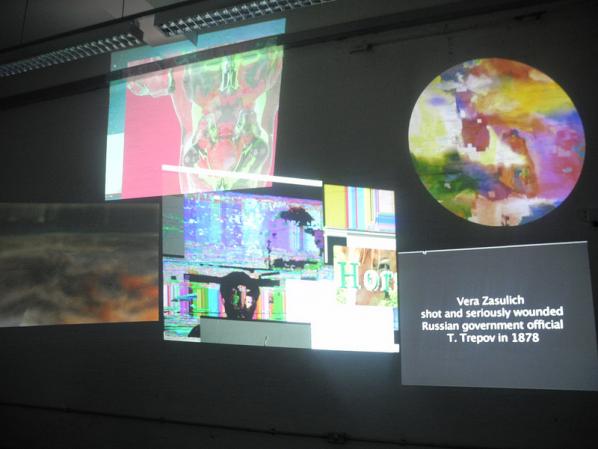
The 8 and 16-bit console software beloved by some Glitch artists is comprehensible to them and to their audiences in a way that 64-bit cloud-based network software is not. The former is therefore a useful artistic proxy for the latter. Defamiliarising the one familiarises the other, and provides a way in to critique its unseen operation through visible means.
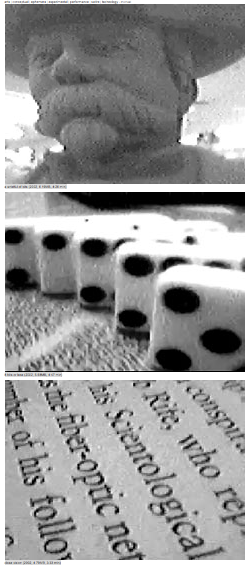
Art makes invisible order tractable by making it visible. Glitch aesthetics are all-over irruptions of the hidden technological order that reveal its operation through its failure. They assert not a reactionary nostalgia but a potential challenge to closure. Engaging with Glitch aesthetics allows us to exercise and develop our regard in a way that increases our fit to the smooth operation and to the catastrophes and contradictions of our post-digital environment.
The text of this review is licenced under the Creative Commons BY-SA 3.0 Licence.
Don’t forget the Glitch Moment/ums exhibition at Furtherfield
Curated by Rosa Menkman & Furtherfield.
Opening Event: Saturday 8 June 2013, 2-5pm
with Glitch Performance by Antonio Roberts at 3pm
http://www.furtherfield.org/programmes/exhibition/glitch-momentums
Featured image: Jon Satrom (left) and jonCates at Intuit, Sept. 20, 2012 (right). image: Shawne Michaelain Holloway
Post-Static: Realtime Performances by jonCates and Jon Satrom @ Intuit, the Center for Intuitive and Outsider Art (Chicago). September 20, 2012. Programmed by Christy LeMaster
“Alchemy; the science of understanding the structure of matter, breaking it down, then reconstructing it as something else. It can even make gold from lead. But Alchemy is a science, so it must follow the natural laws: To create, something of equal value must be lost. This is the principle of Equivalent Exchange. But on that night, I learned the value of some things can’t be measured on a simple scale.”[1]
In 1966, Bell Laboratories scientists and engineers collaborated with artists to construct several performance-based installations under the title 9 Evenings: Theatre & Engineering. Works included Variations VII by John Cage and performance engineer Cecil Coker, in which a sound system pulled sounds from radio, telephone lines, microphones and musical instruments, and Carriage Discreteness by Yvonne Rainer and performance engineer Per Biorn, a dance event controlled by walkie-talkie and TEEM (theatre electronic environment modular system). Critic Lucy Lippard was wrote that the event was filled with technical problems and that the artists involved allowed the technology to take precedence over the art. She pointed out that no theatre people took part in the event and suggested that while this event did not offer a specific design for a new approach to theatre, it revealed the possibility that new approaches to theatre might be born from the combination of art and technology:
A new theater might well begin as a non-verbal phenomenon and work back towards words from a different angle. Departing from Samuel Beckett’s highly verbal, single-image emphasis, it could move into an area of perceptual experience alone, its tools a more primitive use of sight and non-linguistic sound. Such a theater would not necessarily be the amorphous carnival of psychedelic fame but could be as rigorously controlled as any other.[2]
She also observed that it was often impossible to understand the relationship between the technology and the events it triggered without reading the program, mentioning one such missed connection in Open Score, by Robert Rauschenberg and performance engineer Jim McGee. In this piece, tennis rackets were wired such that each impact of the ball on a racket turned off one light in the performance hall. Lippard wrote that this connection was not noticeable and thus the conceptual framework of the piece was lost to the audience.
To artists working at the intersection of art and technology more than forty years after this event, it is disturbing to note that the same issues Lippard pointed out —the subjugation of concept to technology, the failure of the technology itself and the lack of a radical approach to the intersection— are still all too present in many works taking place in the worlds of new media art [3]
. None of these were issues for jonCates or Jon Satrom as each presented a performance intersecting with the exhibition “Ex-Static: George Kagan’s Radios” at Intuit, the Center for Intuitive and Outsider Art in Chicago, IL. Their performances serve as examples of new media employed as a tactic in support of art rather than “new media art” as a condition represented by infatuation with expensive devices. Instead of yet another demo of “cool” tech, the audience experienced a rigorously controlled blast of chaos.
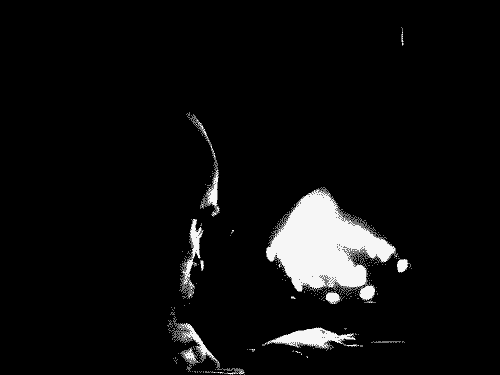
The lights go down completely and we are illuminated by a large amorphous video projection behind a table stacked with equipment. The video is black and white as is the video monitor facing us from the table. jonCates moves between the back and front of the table, with purpose. While the equipment stack is familiar, multiple mixers and cases, this is no DJ set. Much closer is the image of a few men in long sleeves and ties tending to tables full of equipment for John Cage’s “Variations VII”. With several nondescript devices on and adjusted, the air around us has become alive with a noisy drone that, by this date and to this audience, is very familiar (parallels extend back to sonic attacks from Peter Christopherson and Chris Carter with Throbbing Gristle) but now the sound is comforting, an aural field that is neither alien nor distracting.
A droning, machine sound, or the droning machine sound, has become a ridiculously common element of a contemporary “experimental” sound and video work. It is thus all the more surprising to be instantly drawn into jonCates’ audio, to take pleasure in it and to lose track of time completely. We are watching him control the mixer and occasionally speak into the microphone that is set in front of a conspicuous security camera. Again, jonCates uses the most expected situation —the camera faces upward toward the video projection screen, creating a counter-clockwise tilting feedback loop. And again, we are not distracted by this, it is familiar yet beautifully framed and we are drawn in. We have been invited to a field constructed by a tactician expertly employing simple situations.
The raw quality of both the droning audio and the feedback loop combine with jonCates’ humble appearance to remove the expectation of a spectacle and we return to the real situation with questions: who is this man and what is he going to do? He keeps speaking into the microphone, his eyes look desperate, and, despite seeing him perform a similar (although much less engaging) performance at the 2011 Gli.tc/h festival, we are surprised as we realize, as it is nearly two-thirds complete, what he is doing: giving a lecture.
jonCates has been speaking for some time but only a few echoed fragments are reaching out beyond the drone. It has been an incantation without purpose, a repetition of the meaningless words one says when one is presenting something to an audience. Finally, jonCates drops the distortion and the volume on the droning sound and his voice becomes clearer. It is obvious that some communication is going to happen and everyone shifts slightly as we strain to remember how to listen to a voice. Are we here to see another performance or hear something important?. The voice is not strong and it has no authority. It is perfectly ordinary, slightly academic with a hint of vulnerability. It’s the voice of a mad scientist who has begun to understand that his experiments may be his undoing. At this point the piece could collapse and jonCates has not propped himself up with his technology. Instead, he’s used it to lead us to key moments and obliterating everything else. Still, he seems not so much frightened as curious to see where this will end, if what he needs to say can be given a short lifespan in this space. This is where performance lives —in the unfolding present. And jonCates says:
“…and I thought [?] … I thought [?] about how I should remix something in realtime for you that I should reflect upon the past, I should reflect upon [?] …patterns so I thought that I should probably do this as a remix and render it in realtime for you but then I found … from 1997…and it was sitting right next to the first tape … it was sitting right next to the first tape, had the same title as the first one, that also said “Flow” and right next to it had another a label that said “Remix” and I thought ‘I already made that piece’ [sampled voice droning: ‘oceanic waves upon waves upon waves upon waves’] and that’s almost too good to be true so I put the tape called ‘remix’ into the VCR, not this VCR. I had to buy a new VCR that VCR broke and … called ‘remix’ .. rendered in realtime for you … and I watched it, and almost [? ] [?] decide … I had already … [sampled voice droning: ‘we can stay in the spell of the laser lights’] … and I’ve been thinking about these things … [sampled voice droning: ‘we are all together … in the time space continuum of … of … of …’ and the drone continues.]”[4]
“The peculiarity of the time bounce, as he mulled it over, was that the resumption of the earlier state of being not only set physical objects back to their former positions, it actually wiped out the events of the lost hour. Like daylight saving indeed! With the lost hour unhappened, even memories of the time were obliterated…They might be reliving a given moment for the fifth time, the fiftieth, the five millionth, and never notice it!”[5]
“A representation is the occasion when something is re-presented, when something from the past is shown again —something that once was, now is. For representation it is not an imitation or description of a past event, a representation denies time. It abolishes that difference between yesterday and today. It takes yesterday’s action and makes it live again in every one of its aspects —including it’s immediacy. In other words, a representation is what it claims to be —a making present.”[6]
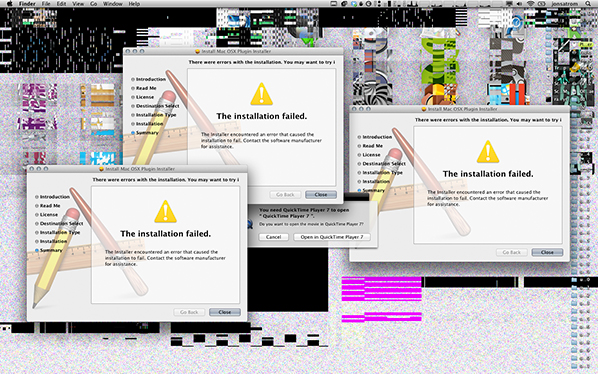
“For every organ-machine, an energy-machine: all the time, flows and interruptions. Judge Schreber has sunbeams in his ass. A solar anus. And rest assured that it works: Judge Schreber feels something, produces something, and is capable of explaining the process theoretically. Something is produced: the effects of a machine, not mere metaphors.”[8]

They are called radio buttons because on old car radios you pushed one button and the other popped out. The performances of jonCates and Jon Satrom were developed as an intersection with the exhibition Ex-Static: George Kagan’s Radios at Intuit, the Center for Intuitive and Outsider Art, on display until January 5, 2013, curated by Erik Peterson and Jeremiah Hulsebos-Spofford.
“In the wee, wee hours your mind get hazy / Radio relay towers lead me to my baby / The radio’s jammed up with talk show stations / Its just talk, talk, talk, talk, till you lose your patience”[9]
jonCates makes Dirty New Media Art, Noise Musics and Computer Glitchcraft. His experimental New Media Art projects are presented internationally in exhibitions and events from Berlin to Beijing, Cairo to Chicago, Madrid to Mexico City and widely available online. His writings on Media Art Histories also appear online and in print publications, as in recent books from Gestalten, The Penn State University Press and Unsorted Books. He is the Chair of the Film, Video, New Media & Animation department at the School of the Art Institute of Chicago:
http://systemsapproach.net/
Jon Satrom undermines interfaces, problematizes presets, and bends data. He spends his days fixing things and making things work. He spends his evenings breaking things and searching for the unique blips inherent to the systems he explores and exploits. By over-clocking everyday digital tools, Satrom kludges abandonware, funware, necroware, and artware into extended-dirty-glitchy-systems for performance, execution, and collaboration. His time-based works have been enjoyed on screens of all sizes; his Prepared Desktop has been performed in many localizations. Satrom organizes, develops, and performs with I ♥ PRESETS, poxparty, GLI.TC/H, in addition to other initiatives with talented dirty new-media comrades.
http://jonsatrom.com/
The Glitch Moment(um)
Rosa Menkman
Institute Of Network Cultures, 2011
ISBN 9789081602167
Rosa Menkman’s book “The Glitch Moment(um)” is a comprehensive study of the theory, practice and social context of contemporary digital Glitch Art. Glitch Art is similar to the ironisation of the noise of old media into cultural signals seen in Trip Hop and that is the basis for the nostalgic image-making of Lomography or Instagram. But it is based on current digital technology, rather than past analogue technology.
Glitch Art is growing in popularity and critical attention, and is already being recuperated by the mass media (for example in a recent Calvin Klein perfume television advertisement). Analogue glitches have been part of art and popular culture for decades, for example in Nam June Paik’s television-based art or the titular character of the cyberpunk TV show “Max Headroom”. Digital glitches and their simulation featured in the postmodern graphic design of the early 1990s created by groups such as Designers’ Republic. But between a history of analogue media and a future of mass media recuperation there is the current Moment(um) of digital glitch aesthetics that Menkman identifies.
Menkman begins by explaining the basics of Shannon/Weaver information theory as the basis for a theory of what glitches are. In information theory, messages are sent as a signal from a transmitter to a receiver over a channel which is disrupted by a source of noise. This “noise” is the crackle on analogue telephones or on vinyl records, the static on analogue TV and radio, and the corruption that sometimes affects digital images or audio streams (nowadays notably Skype chats).
Where kinds of noise are associated with a particular we can recognise them as particular “noise artifacts”. We can also recognise compression artefacts in digital media such as those seen in over-compressed lossy image and video files (JPEG and MPEG artefacts). These noise and compression artifacts are experienced by the users of communication media as glitches. Menkman describes these phenomena in detail, providing the reader with a firm foundation in the sources and expression of Glitch phenomena.
How artists can deliberately create these phenomena is the subject of the next section of the book. Titled “A Vernacular Of File formats” it is a condensed adaptation of Menkman’s 2010 artwork of the same name. It is a thorough and accessible resource for both understanding the production of and creating visual glitch aesthetics. Each picture demonstrates a technique for modifying the data of an image file format so that a computer can still parse and render the file but it will appear corrupted to a human viewer. Starting with an uncorrupted (but unnervingly contrasty) “RAW” image, Menkman explains the production and principles of corrupted digital images in sufficient detail that the reader can recreate and build on these techniques themself, or use this knowledge as the basis for understanding and appreciating the work involved in the Glitch Art produced by others.
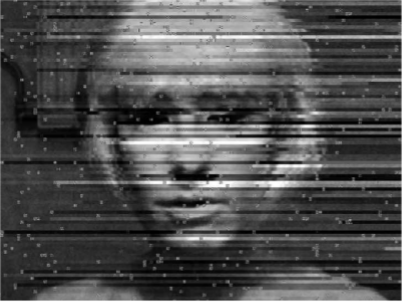
The next two chapters cover the phenomenology and philosophy of Glitch. The theories of Paul Virilio and Alan Liu are usefully deployed here to give Glitch a philosophical grounding. But there is also a recognition that Glitch is an inherently open concept that is difficult to define. Menkman rightly considers the work of Beflix (Ant Scott) as a leading Glitch Art figure. The diversity of Beflix’s work illustrates the problem with categorizing Glitch neatly, or at all. 5VOLTCORE, JODI, and others provide alternative views of what Glitch can be. This builds to Menkman defining “Glitchspeak” as the vernacular, or in possibly the creole, of Glitch Art.
In “From Artifact To Commodity”, Menkman turns to Glitch aesthetics in music, particularly the glitches created through circuitbending, and the precedent this has set for the creation of standardized tools for glitching visual media. As such tools have been created for images, Glitch aesthetics have found their way into the artistic mainstream and into music videos and other mass media. Glitch may be impossible to categorize but it is all too easy to commodify. This marks its emergence as a genre, and Menkman finishes this section by considering Glitch as a recognizable but still problematic genre that relies heavily on spectators’ technical, aesthetic and theoretic literacy.
Having given the reader a solid grounding in the theory, practice and philosophy of Glitch, Menkman finally moves on to its sociology. Using a tool that looks like Gephi but isn’t (Issuecrawler), Menkman models the social network of relationships between Glitch artists that exist on the Internet. Clustering blogs and other Internet expressions by the number of links between them allows the tools of social network analysis to be used, revealing who is central to the Glitch artworld as judged by the clicks of their peers.

Finally Menkman sums up Glitch aesthetics in a section called “The Emancipation of Dissonance Glitch”. Starting with a quote from Jackson Pollock:
“I don’t use the accident. I deny the accident. There is no accident, just as there is no beginning and no end.”
Menkman concludes that “Like the best ideas, glitch practices are dangerous because they generate awareness”. By which point the reader is perfectly placed to understand just how and what kind of awareness Glitch generates, and how they can appreciate or produce Glitch art themselves.
Glitch Art has been long overdue serious critical attention. I cannot remember the last time I read a book that so thoroughly and concisely presented the theory and practice of a contemporary art movement in as does “The Glitch Moment(um)”.
You can download a PDF or order a print copy here
The text of this review is licenced under the Creative Commons BY-SA 3.0 Licence.